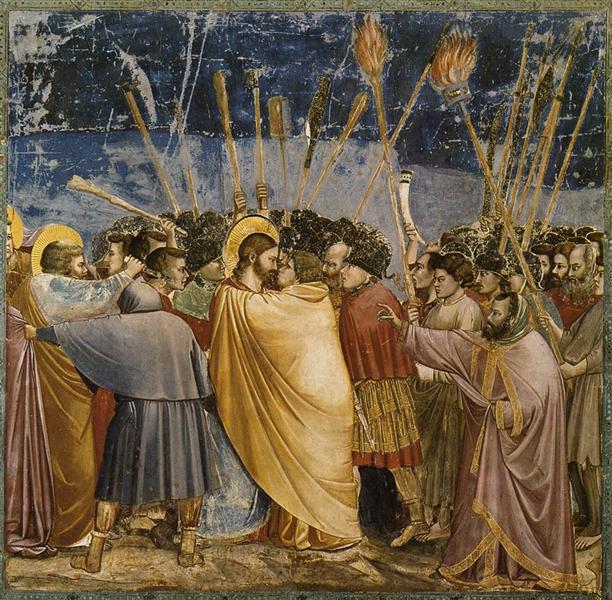Judas Iscariot is one of the most tragic and mysterious figures in Scripture. His betrayal of Christ has been attributed to multiple causes—greed, political disillusionment, and even direct influence from Satan. Yet, beneath all these lies a deeper and more unsettling factor: his rejection of Christ’s teaching on the Eucharist.
The Motives for Betrayal
Greed and the Love of Money
Judas was entrusted with the communal money, but John 12:6 reveals that he was a thief. His attachment to wealth may have made him resentful of Christ’s teachings on poverty and sacrifice, leading him to sell Jesus for thirty pieces of silver (Matthew 26:14-16). This attachment to material wealth manifested particularly in the episode where Mary anointed Jesus with costly perfume. While others saw a beautiful act of devotion, Judas could only calculate its monetary value, complaining that it could have been sold for three hundred denarii. His objection, cloaked in concern for the poor, revealed his true priorities.
A Political Miscalculation
Many believe Judas expected Jesus to be a political Messiah who would overthrow Roman rule. When it became clear that Christ’s mission was spiritual rather than militant, Judas may have become disillusioned and sought to force Jesus’ hand or abandon Him altogether. The disappointment that Jesus didn’t conform to his expectations of worldly power might have turned admiration into resentment, especially as Jesus spoke increasingly about His coming death rather than His triumph over Rome.
Satan’s Influence
Luke 22:3 states that Satan entered Judas. His persistent sin and lack of faith gave the devil an opening, and instead of resisting, Judas succumbed. This spiritual possession wasn’t arbitrary—it was the culmination of small compromises, unconfessed sins, and spiritual hardening that made Judas particularly vulnerable to diabolic influence. The enemy recognized in Judas a soul already wavering and exploited this weakness to accomplish the betrayal.
The Deeper Revelation: Judas and the Eucharistic Crisis of Faith
While these explanations—greed, political disappointment, and diabolic influence—offer partial insights into Judas’s betrayal, Scripture reveals a more fundamental spiritual crisis at work. The evangelist John, who alone records the Bread of Life discourse and its aftermath, provides us with a revelation that illuminates the true spiritual root of Judas’s betrayal.
When we examine the chronology of the Gospel of John, a startling pattern emerges. The pivotal moment occurs in John 6, where Jesus declares Himself the Bread of Life and insists that His followers must eat His flesh and drink His blood to have eternal life. This teaching caused many disciples to abandon Him, declaring, “This is a hard saying; who can listen to it?” (John 6:60). As the crowds dwindled, Jesus turned to the Twelve and asked if they too would leave.
It is precisely at this moment—immediately following this Eucharistic teaching—that John records Jesus’ first reference to the betrayer:
“Did I not choose you, the Twelve? And yet one of you is a devil.” (John 6:70)
John immediately clarifies: “He spoke of Judas the son of Simon Iscariot, for he, one of the Twelve, was going to betray him” (John 6:71).
This juxtaposition is no mere coincidence. John, writing decades after the events and guided by the Holy Spirit, deliberately connects Judas’s future betrayal with this crisis of Eucharistic faith. While Peter professes, “Lord, to whom shall we go? You have the words of eternal life” (John 6:68), Judas remains silent. Though physically present among the Twelve, John reveals that spiritually, Judas had already separated himself through unbelief.
The theological implication is revealing: Judas, like those who walked away, could not accept Christ’s Eucharistic teaching. Unlike them, however, he lacked the integrity to depart openly. Instead, he remained with Jesus—but in disbelief and hypocrisy, creating a spiritual dissonance that would ultimately manifest in betrayal. His external conformity masked an internal rejection that festered until it found expression in the ultimate act of treachery.
The Dipped Bread: A Symbol of Betrayal and Unworthy Reception
At the Last Supper, Jesus identified His betrayer by offering him a morsel of dipped bread (John 13:26-27). This act was deeply symbolic:
A Gesture of Friendship Turned to Treachery
In Jewish custom, offering dipped bread was a sign of favor and intimate friendship. At Middle Eastern meals, the host would sometimes honour a guest by hand-feeding them a choice morsel. Jesus extended one final chance for Judas to repent, transforming what should have been a moment of communion into an opportunity for conversion. Instead, Judas hardened his heart, turning this sacred gesture of fellowship into the catalyst for betrayal.
A Prefiguration of the Eucharist
The dipped bread, combining bread and liquid, echoes the two species of the Eucharist. Judas’ reception of it without faith parallels unworthy reception of Communion. The bread dipped in wine (or sauce) represented a miniature version of the greater sacramental reality being instituted at that same meal. Where the other disciples would soon receive the Body and Blood with faith, Judas received its prefigurement with treachery in his heart.
Immediately after receiving it, Satan entered him, and he left to betray Christ (John 13:27-30). This foreshadows St. Paul’s later warning that those who receive the Eucharist unworthily bring judgment upon themselves (1 Corinthians 11:27-30). The spiritual consequences were immediate—what should have been a moment of grace became an occasion for deeper darkness. The sacred gift, received without proper disposition, became not a source of blessing but an opportunity for greater evil.
Judas as a Warning for Today
Judas’ disbelief mirrors the modern crisis of faith in the Eucharist. Recent surveys indicate that many Catholics today do not believe in the Real Presence, and unworthy reception is widespread. His example warns us that:
It is possible to be close to Christ externally but not truly believe. Many today participate in the external rituals of faith while internally rejecting its core teachings, creating the same kind of dissonance that characterized Judas.
Receiving the Eucharist without faith and repentance is spiritually dangerous. The sacrament, designed to increase grace, can have the opposite effect when received in a state of serious sin or disbelief.
Betrayal of Christ begins in the heart long before external actions. Judas didn’t suddenly decide to betray Jesus—his action was the culmination of a long process of interior alienation, beginning with his rejection of Christ’s teaching.
Peter vs. Judas: Two Responses to Failure
Both Peter and Judas failed Jesus. Peter denied Him three times after promising absolute fidelity, while Judas betrayed Him with a kiss after years of discipleship. The difference was in their response:
Peter repented and was restored (Luke 22:62, John 21:15-19). His bitter tears led to renewed commitment, and his failure became the foundation for a humbler, more compassionate ministry.
Judas despaired and was lost (Matthew 27:5). His remorse led not to reconciliation but to self-destruction, closing the door to the very mercy he had helped proclaim to others.
These contrasting responses reveal the critical distinction between genuine repentance and mere regret. Peter’s failure led him back to Christ; Judas’s led him further away. Every Catholic faces the same choice when confronting personal failure: to acknowledge our sins and seek mercy or to persist in disbelief and betrayal.
The Call to Eucharistic Revival
To restore faith in the Eucharist, we must:
Teach the Real Presence
Strengthen catechesis on the Eucharist as Christ’s Body and Blood through doctrinal clarity, historical continuity, and mystical understanding. Revitalizing Eucharistic education requires addressing both intellectual objections and spiritual resistance, presenting the doctrine not merely as a theological concept but as the loving presence of Christ Himself.
Encourage Worthy Reception
Promote frequent Confession and reverent reception of Communion. The preparation for Communion is as important as the reception itself. By rediscovering the practice of spiritual and sacramental preparation, we create the proper disposition for encountering Christ in the Eucharist. This includes encouraging proper fasting, attentive participation in Mass, and regular examination of conscience.
Deepen Eucharistic Devotion
Foster Eucharistic Adoration and a renewed love for the Blessed Sacrament. Extended time in Christ’s presence outside of Mass can reawaken the sense of wonder and mystery that makes meaningful participation in Mass possible. Parishes that prioritize Adoration often see renewed reverence in the liturgy itself, as the practice reinforces the reality of Christ’s presence.
Conclusion: Learn from Judas, Choose Like Peter
Judas’ tragedy is a warning, but we are called to a different path. Let us believe where he doubted, repent where he despaired, and love Christ in the Eucharist where he betrayed Him. The Eucharist is Christ Himself—may we receive Him with faith and reverence.
The path of Judas seems remote from our everyday experience, yet every disbelieving communion, every irreverent reception, every hardened heart before the Blessed Sacrament repeats in miniature his fundamental error. Conversely, every act of Eucharistic faith, every reverent reception, every moment of adoration joins us to Peter’s restoration and the disciples’ fidelity.
In the face of modern Eucharistic crisis, we stand at the same crossroads as these two apostles—believing or betraying, receiving in faith or rejecting in doubt. May we choose, with Peter and against Judas, the path of faith, repentance, and eternal communion with the Lord we receive.



